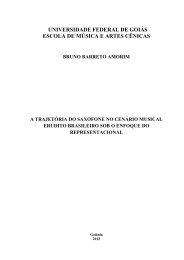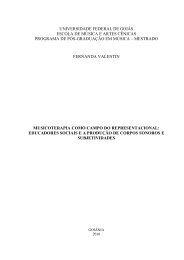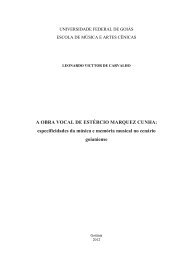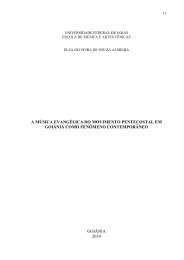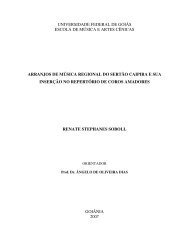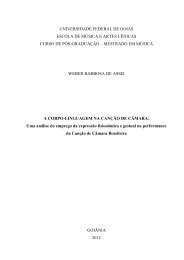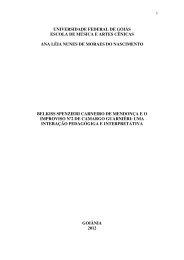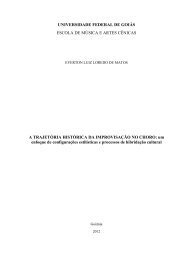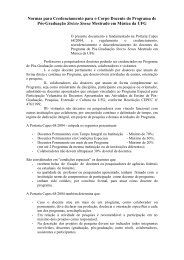Download - Mestrado em Música e Artes Cênicas - UFG
Download - Mestrado em Música e Artes Cênicas - UFG
Download - Mestrado em Música e Artes Cênicas - UFG
Create successful ePaper yourself
Turn your PDF publications into a flip-book with our unique Google optimized e-Paper software.
“ESTUDO I” FOR SOLO CLARINET BY JOHNSON MACHADO:<br />
ANALYTICAL ASPECTS THROUGH POST-TONAL THEORY<br />
Johnson Machado (<strong>UFG</strong>)<br />
johnsonmachado@hotmail.com<br />
Keywords: Cont<strong>em</strong>porary Music; Estudo I; Clarinet; Post-Tonal Theory.<br />
INTRODUCTION<br />
The Estudo I for solo clarinet represents a virtual compendium of extended techniques for<br />
the clarinet. It was written in 2003 in an att<strong>em</strong>pt to promote and divulge the extended techniques<br />
among clarinetists and composers. This writer has been performing the piece since then in recitals,<br />
festivals and s<strong>em</strong>inars in Brazil and in the US. The work calls one’s attention in that in contains<br />
many of the techniques in one piece, offering the musician the opportunity to listen th<strong>em</strong><br />
as well as to motivate the study and performance of the work. However, the performer must be<br />
willing to alter the habits he uses in performing traditional music. For example, Donald Scarvada<br />
describes his experience in dealing with these new techniques. He recalls his unique experience,<br />
observing that:<br />
It was in trying to find sounds that were most natural to the clarinet that I discovered what are<br />
now called multiphonics in April 1962. Gradually I began to realize the exciting potential of<br />
the simultaneity of sounds that could be produced by the instrument. It was necessary first,<br />
however, to discard old habits and attitudes about what the clarinet should sound like. It required<br />
an open mind and much hard work and patience to explore and mine these rich, natural<br />
complex sounds and eventually to bring th<strong>em</strong> to the surface (Scavarda, 2001).<br />
Objective<br />
To promote and divulge both the extended techniques for the clarinet and the piece Estudo<br />
I among clarinetists, composers and musicians. Furthermore, it is expected that it may motivate<br />
artists in a more frequent way with the use of the extended techniques in schools and conservatories,<br />
enabling the students to this particular field.<br />
Methodology<br />
This article is based on the piece Estudo I and through the appreciation and study of its<br />
analytical aspects, using the post-tonal theory as a tool to understand and enumerate the nuances<br />
found in the piece one is expected to grasp the ideas that permeates the work accordingly. Thus,<br />
methodology becomes assertiveness towards its experiments and quality.<br />
Expected Results<br />
The understanding of the extended techniques as well as their use among musicians may<br />
promote the practice and performance in a more fluent way.<br />
Comunicações Orais 55



